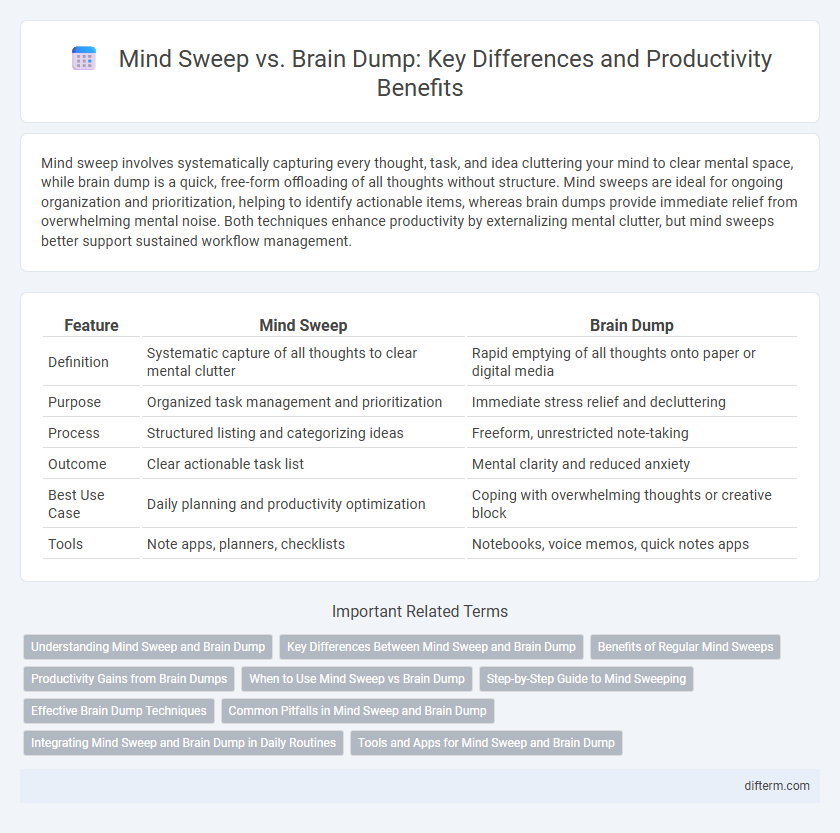Mind sweep involves systematically capturing every thought, task, and idea cluttering your mind to clear mental space, while brain dump is a quick, free-form offloading of all thoughts without structure. Mind sweeps are ideal for ongoing organization and prioritization, helping to identify actionable items, whereas brain dumps provide immediate relief from overwhelming mental noise. Both techniques enhance productivity by externalizing mental clutter, but mind sweeps better support sustained workflow management.
Table of Comparison
| Feature | Mind Sweep | Brain Dump |
|---|---|---|
| Definition | Systematic capture of all thoughts to clear mental clutter | Rapid emptying of all thoughts onto paper or digital media |
| Purpose | Organized task management and prioritization | Immediate stress relief and decluttering |
| Process | Structured listing and categorizing ideas | Freeform, unrestricted note-taking |
| Outcome | Clear actionable task list | Mental clarity and reduced anxiety |
| Best Use Case | Daily planning and productivity optimization | Coping with overwhelming thoughts or creative block |
| Tools | Note apps, planners, checklists | Notebooks, voice memos, quick notes apps |
Understanding Mind Sweep and Brain Dump
A mind sweep involves systematically capturing all thoughts, tasks, and ideas from your mind to an external system, aiming to clear mental clutter and prioritize effectively. A brain dump is a rapid, unstructured outpouring of everything on your mind, helping to release stress and gain initial clarity without immediate organization. Both techniques improve productivity by transferring cognitive load from the brain to a tangible format, but the mind sweep emphasizes organization while the brain dump focuses on sheer expression.
Key Differences Between Mind Sweep and Brain Dump
Mind sweep involves systematically capturing all thoughts and tasks from your mind to clear mental clutter, promoting organized task management. Brain dump is a free-form expression where you transfer any ideas, worries, or information onto paper or digital format to improve clarity and reduce cognitive load. The key difference lies in mind sweep's structured approach aimed at prioritization, whereas brain dump emphasizes unfiltered release for immediate mental relief.
Benefits of Regular Mind Sweeps
Regular mind sweeps enhance productivity by systematically clearing mental clutter, allowing for sharper focus on priority tasks and reducing cognitive overload. This practice improves task organization and time management by capturing loose thoughts, commitments, and ideas in a centralized system for effective review and delegation. Consistent mind sweeps cultivate mental clarity and reduce stress, supporting sustained motivation and improved decision-making throughout demanding workdays.
Productivity Gains from Brain Dumps
Brain dumps enhance productivity by rapidly transferring mental clutter onto paper, freeing cognitive resources for focused task execution. Unlike mind sweeps that methodically organize thoughts, brain dumps prioritize speed and quantity, enabling immediate clarity and reduced stress. This process leads to increased task completion rates and better time management by minimizing decision fatigue.
When to Use Mind Sweep vs Brain Dump
Use a mind sweep to systematically capture all thoughts, tasks, and ideas scattered throughout your mind, especially during periods of overwhelm or mental clutter. Opt for a brain dump when you need to quickly unload everything on your mind onto paper without structure, ideal for stress relief or jumpstarting creative processes. Both techniques enhance productivity by clearing mental space but serve different purposes based on the need for order versus spontaneous expression.
Step-by-Step Guide to Mind Sweeping
Mind sweeping involves systematically capturing every thought, task, or concern into a trusted system to clear mental clutter and improve focus. Start by setting a timer for 15 minutes, then write down all ideas, tasks, and reminders without filtering, ensuring nothing is overlooked. Reviewing and organizing these items into actionable categories helps optimize workflow and boosts overall productivity.
Effective Brain Dump Techniques
Effective brain dump techniques enhance productivity by clearing mental clutter and organizing thoughts efficiently. Prioritizing tasks during a brain dump ensures focus on high-impact activities, while categorizing ideas into actionable items promotes clarity and execution. Combining timed sessions with minimal distractions maximizes the benefits of mind sweeps and brain dumps in daily workflows.
Common Pitfalls in Mind Sweep and Brain Dump
Common pitfalls in mind sweeps include overwhelming mental clutter due to lack of clear categories, leading to inconsistent organization of tasks and ideas. Brain dumps often suffer from poor prioritization and incomplete capture of relevant information, causing essential tasks to be overlooked. Both techniques require structured follow-up to convert raw thoughts into actionable plans, ensuring higher productivity and reduced cognitive load.
Integrating Mind Sweep and Brain Dump in Daily Routines
Integrating mind sweep and brain dump techniques enhances productivity by systematically clearing mental clutter and capturing all thoughts in one place. Mind sweeps regularly scan the mind for outstanding tasks and ideas, while brain dumps involve transferring all these thoughts onto paper or digital tools, enabling better prioritization and action planning. Combining both methods in daily routines improves focus, reduces stress, and streamlines task management for optimal efficiency.
Tools and Apps for Mind Sweep and Brain Dump
Mind sweep tools like Microsoft OneNote, Evernote, and Notion help capture and organize scattered thoughts through structured note-taking and tagging features. Brain dump apps such as SimpleMind, MindMeister, and Milanote offer visual mapping capabilities that enable users to release and categorize ideas rapidly. Combining these tools enhances productivity by facilitating comprehensive mental clarity and efficient task management.
Mind sweep vs Brain dump Infographic

 difterm.com
difterm.com